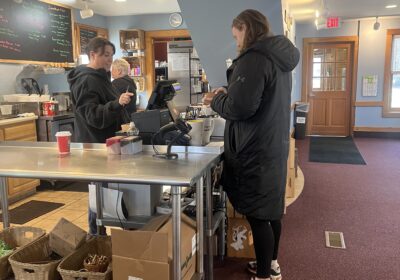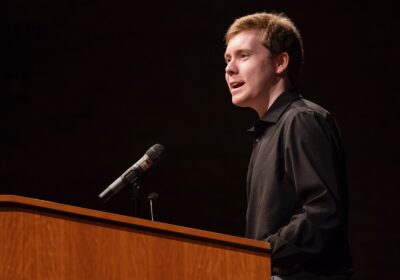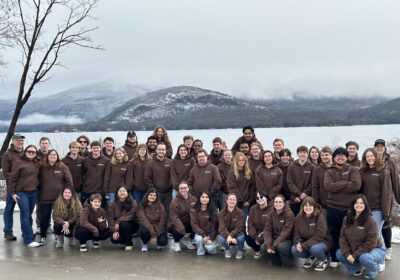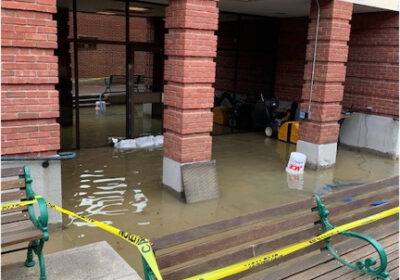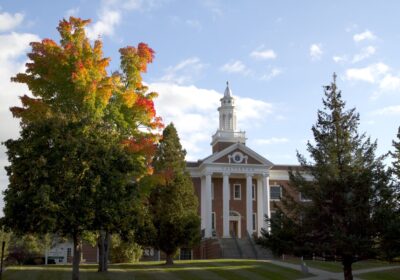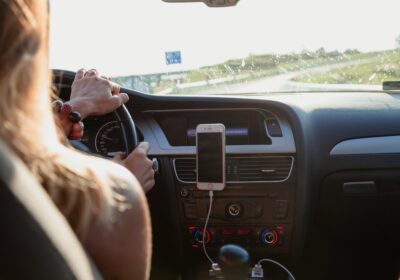Accident fosters Leavenworth love
Casltleton University history professor Trish van der Spuy is fiercely independent, and all of her colleagues will tell you that.But on Sept. 6, all that changed. “I was taking my two little, ancient, geriatric dogs out, after it had rained and was distracted,” she says. “I slipped on the top step and landed three steps down on the ground.”
As she narrates the fall, something about her changes. The disappointment that comes through her voice and across her face is starkly different from the way she normally smiles and greets you in her peppy South African accent. Hints like this give away how much of a toll this ordeal has taken on her.
“I landed on my left side,” she says, layering her hands on one another trying to give a visual of the way it occurred. “I knew that my ankle was sore – and then I saw my right leg come down and my right foot hit the ground at a really weird angle and I heard a click.
“I sat there on the ground with my dog for about 10 minutes, managed somehow to get up the stairs.”
She didn’t know it at the time, but she had broken not just one, but both of her ankles, coupled with ligament damage in her left for good measure.
Her only real option now is to use a wheelchair, which leaves her incredibly dependent on the help of others.
What was the typical scene in and around her office plays out very differently these days.
A new routine has van der Spuy frequently being seen being pushed in her chair by global studies professor Adam Chill. They come down the hallway, excusing themselves past students and faculty, smiling as they chat.
Chill stops at her office door as she lets herself in, looking her doorknob directly in the eye from the new vantage point her wheelchair offers.

History professor Adam Chill has frequently been seen helping Professor Patricia van der Spuy get to class. Photo by Zach Castellini-Dow.
“Did you get my message about 3:30?” van der Spuy asks.
“I did. I can’t, unfortunately,” Chill says almost wincing because he doesn’t want to let her down. ”Did you try Melisse?”
“I will,” she says, still smiling. “Be sure to take your books.”
Chill recounted his involvement with van der Spuy in the days following her accident.
“I saw her in her office, and I was taking her home that day because she couldn’t drive,” he said. “She tried to walk to the elevator and she made it 10 feet.
“She was in real pain,” he says with clear concern,” and on the way home I told her she had to get to the hospital and in the morning she sent me a text saying ‘Alright, let’s go to the ER.’”
Since the incident, her fellow professors have stepped-up every way imaginable to help her. They’ve driven van der Spuy to and from work every day, brought her fresh vegetables from the farmer’s market and have even offered to take care of her dogs.
Melisse Pinto, a political science professor, has been one of her bigger helpers.
“It just seemed natural,” Pinto said offering that she’s glad to help her be, “devoted to her students.”
She also reiterated that van der Spuy, like the rest of the professors at Castleton likes her independence, and she thinks that because of this she thinks that van der Spuy, “doesn’t want to impose on anyone.”
But professors aren’t the only ones helping her out. Much like her sense of independence, van der Spuy’s classroom has also changed. She still commands the classroom, but from a new level – approximately half the height she normally stands at. Students now weave their heads around those of students in front of them trying to engage in discussion.
Now a single student typically stands at the podium, working the images and maps she’s compiled on her Moodle page for each class to bring a sense of imagery into the text that can lose your attention from time-to-time.
In her African History course this semester, junior Noah Richer is one who has stepped up.
“There is a good group of five or six of us helping her,” he recalls about the first class he had after she returned, “and you can tell on her face that her admiration is real.”
He smiled as he said, “This is kinda like our way of giving back to her,” and the look of appreciation in his eyes was clear. “How much the professors put into their classes shows us they go out of their way to show us they want us to benefit.”
The outpouring of help she has enjoyed is characterized by van der Spuy as this sense of the “Leavenworth community.” She has had random professors stop in to help her to her next class, familiar students who she can count on to fetch her a refill of water from the fountain and even random students who have seen her struggling.
Everyone has been helping.
What does this term “Leavenworth Community” mean to the students? Aside from helping their professor in any way shape or form, the students seem to agree that it’s the open-door policy that every professor seems to follow.
Joshua Lake, a senior political science and history student, claims it’s what drove him to come here in the first place. On his first trip to Castleton, then still the state college, he noticed something different about Leavenworth.
“Every door in the department was open,” he said with pride in his department, before adding, “I ditched my tour and I talked to Professor Fleche.”
Really, it boiled-down to a very simple comparison for him.
“Do I want to go to a university where I’m just a number on a roster or do I want to go somewhere where everyone knows my name and has this open-door policy,” he questioned, knowing the answer. When professors weigh in on what they think really drives this sense of a Leavenworth Community, their answers all seem to be focused on their colleagues.
They all say that the level of respect that they give one-another and receive is the cornerstone of their community, but something else also seems to be gluing them together.
“We have a group of not just professors, but students,” says geography professor Scott Roper, “who help each other and appreciate each other.”
He also points to Leavenworth Administrative Assistant Pam Alexander.

Administrative Assistant Pam Alexander is a big part of the Leavenworth Hall family. Photo by Zach Castellini-Dow.
Alexander is someone every single professor mentions when faced with this question. Her office is tucked into a corner right at the entrance to the English Department. Her award on the wall reads “Outstanding New Faculty and Staff, “and it is decidedly too small for the reasons it exists.
Alexander has this list that she keeps neatly filed away in a drawer – a list of the birthdays of every faculty member in the building. Every month, Pam bakes some sort of dessert and makes up a colorful list of each member of the faculty whose birthday falls in that month and leaves the spread in the faculty lounge upstairs.
When asked what her colleagues mean to her, Alexander said, “They’re the most considerate and respectful group I’ve worked with here in Castleton,” adding it’s that, “consideration” that grants her this energy to do things for the staff.
“It’s really, really cool for us to feel valued like that – to make us feel important,” says Chill, adding that her efforts help to alleviate stress and boost “morale.”
The stories don’t stop there, and they even include Leavenworth’s longtime custodian, the always smiling Tita Annis. Leavenworth dwellers say it would be impossible to get down all of the people who have helped van der Spuy, detail all of the ways students appreciate the community in Leavenworth and describe the effort that Pam Alexander builds on to help the community and keep it together.
Perhaps van der Spuy summed it up the best when she said, “Tita and I agree, both of us coming from other countries with no relatives in the U.S. – the Leavenworth community is our family.”

